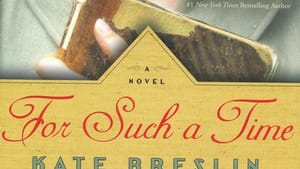Stay in the Loop
BSR publishes on a weekly schedule, with an email newsletter every Wednesday and Thursday morning. There’s no paywall, and subscribing is always free.
Is Esther the right model for the heroine of a Christian romance novel?
'For Such a Time' by Kate Breslin

Kate Breslin’s 2014 Nazi romance novel (or, as she categorizes it, “inspirational fiction”), For Such a Time, won industry accolades as a finalist for a Christy Award (Honoring and Promoting Excellence in Christian Fiction), RITA Award (presented by Romance Writers of America), and CAROL Award (presented by American Christian Fiction Writers), and received Christian Retailing’s 2015 Best-Selling Award for a First-Time Author.
I’ve taken this information from Ms. Breslin’s website, where, describing the book, she also mentions that she enjoys “writing stories about wounded, complex heroes and the smart heroines who rescue them.” Take a moment to process all that. It’s a lot, but it’s made easier by the complete lack of Jewish organizations or publishers rushing to honor her effort.
Is the book well-written and exciting? It’s good enough for what it purports to be. Does that matter? Not at all, considering the rotten foundation on which it rests. The hero she describes is Aric Von Schmidt, fictional Kommandant of the very real Theresienstadt concentration camp. The “smart heroine” who saves him is Hadassah, a girl he rescued from Dachau and installed as his personal secretary because her blond hair, blue eyes, and forged papers fooled him into believing she was mistakenly imprisoned. She is, of course, Jewish.
To recap: This is a romance about a Jew saved from a concentration camp by a Nazi concentration camp commander who then drafts her into slavery with the looming threat of additional sex slavery. Great BDSM porn is made of plotlines like this (which may be why Anne Rice rushed to its defense). Romance, not so much.
Retelling Esther
It’s really important to lay out the depth of the Christian fiction world’s transgressions here. Breslin placed her parasitic tale not just in the Holocaust, but on the back of the Megillah, the Hebrew scroll that tells the story of King Ahasuerus of ancient Persia, Haman’s attempt to exterminate the Jewish people, and Queen Esther and her uncle Mordecai’s plan to save them. It’s the only book in Hebrew scripture that doesn’t mention the name of God, which makes it an odd choice for a work of Christian fiction.
But it’s downright appalling that Breslin’s happy ending includes Hadassah’s growing interest in the New Testament. After all, the reason the Purim story is celebrated in synagogues every year, why Jews obey the commandment that they should drink so much they “can’t tell the difference between ‘cursed be Haman’ and ‘blessed be Mordecai’” is that Esther’s ingenuity was a triumph for the Jewish people in the face of overwhelming odds, not because Jews learned to love Zoroastrianism.
There’s also a bit of cynicism at work. For Such a Time’s publisher, Bethany House, has seen significant success with this particular subject matter, in its Zion Covenant and Zion Chronicles series by Bodie and Brock Thoene, which presumably put them in the market for more Jewish-themed Christian fiction. On her website, Breslin says she was “shopping [her book] around in the secular market,” but “grew in my faith.” As a result, writing the novel “set me on a new path of spiritual growth that led to success.” She “had a deep calling to put something good out into the world. Something that was a good fit for me.”
Ignoring the facts
What wasn’t a good fit for her were the events of the actual Holocaust, in which no Nazi Kommandant or his Jewish girlfriend diverted a train transport full of Jews and led them to freedom. Similarly, when the Red Cross visited Theresienstadt, they did not witness a prisoner revolt (there was, of course, the prior Warsaw ghetto uprising, but since it was led by Godless Communists, it would have been a poor fit for both Breslin and Bethany House). The three Red Cross inspectors, in fact, inspected very little. They did not notice they were seeing a sham specifically constructed for the visit — the subversive children’s performance of Brundibár and its anti-Hitler subtext are never mentioned — and never returned to learn that as soon as they departed most of the camp’s population was sent to Auschwitz to be gassed on arrival.
Readers of Holocaust literature know there were no tales of redemption or joy in the camps, just bitterness, betrayal, anguish, and the luck of surviving another day paired with the misfortune of the same. To write a scene in which a barracks full of starving, beaten Jews, all of whom have lost their livelihoods, possessions, loved ones, and freedom to Nazi barbarism, cheer Aric’s marriage proposal to Hadassah is to romanticize them out of their own humanity. It might be a good fit for Breslin, but it spits in the face of everyone who suffered through or lost anyone in the Holocaust, a demographic that includes much of American Jewry.
Spinning fiction from facts
So, what’s the difference between Breslin’s book and a revenge fantasy like Quentin Tarantino’s Inglourious Basterds? Well, for one, while Tarantino uses the Holocaust as a backdrop, he never befouls the memory of those in the camps. Also, the movie’s ending is ridiculous in the most satisfying (and heartbreaking) way but would never be mistaken for history. Breslin, on the other hand, manipulates actual war crimes to better humanize a Nazi. This is a woman who used Holocaust Remembrance Day not to remember or publicly discuss the Holocaust and its victims, but rather as an opportunity to hold a drawing in which she gave copies of her book to one reader and the lucky public library of his or her choice. I guess that was a better fit.
In recent years, the Jewish community has grappled with accepting and welcoming the support of evangelical Christians. Because of these churches’ unwavering stance on Israel, many Jews consider the concomitant evangelizing a small price to pay. But For Such a Time illustrates the danger of that alliance. Obviously, without interfaith understanding and cooperation, we’re all in trouble. However, there’s a great difference between mutual respect and paternalism. If Christians feel welcome to co-opt Jewish history and traditions for their own purposes — even if they claim, as Breslin does, to do so out of love for the Jewish people — and Jews don’t speak out, we will end up losing that history and those traditions. The Jewish experience might be a good fit for Christian marketing, but like the real victims of Theresienstadt, we may soon find ourselves absented from our own narrative.
What, When, Where
For Such a Time by Kate Breslin. Bethany House Publishers, 2014. Available at Amazon.
Sign up for our newsletter
All of the week's new articles, all in one place. Sign up for the free weekly BSR newsletters, and don't miss a conversation.

 Wendy Rosenfield
Wendy Rosenfield